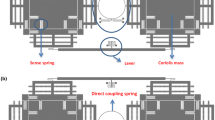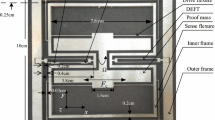Abstract
A two degrees of freedom (DOF) coupled model is investigated in this paper to analyze the acceleration sensitivity of MEMS tuning fork gyroscopes (TFG) and approaches of decreasing the acceleration sensitivity are presented. Since two tines of TFGs are asymmetric in the mass, stiffness and damping caused by the technological defects, there exists the coupled effect between two tines leading to the invalidity of a single DOF model. Therefore, a two DOFs model is established and the matrix perturbation technique is used to calculate the dynamic responses of the two tines by applying the common-mode acceleration. Our quantitative analysis reveals that the displacement difference is large in the in- and anti-phase modal frequencies between two tines, arising from the unsynchronized motion of two tines due to stiffness imbalance. The FEM simulations coincide with our theoretical calculations. Meanwhile, we take advantage of the experimental data from the other researches to verify our theoretical model and analytical expressions. Our results demonstrate that the acceleration sensitivity of TFGs can be reduced by increasing the coupled stiffness ratio, modal frequency and sense beams widths which are insensitive to technological dispersions.








Similar content being viewed by others
References
Alper SE, Akin T (2004) Symmetrical and decoupled nickel microgyroscope on insulating substrate. Sens Actuator A Phys 115(2):336–350
Azgin k, Temiz Y, Akin T (2007) An SOI-MEMS tuning fork gyroscope with linearly coupled drive mechanism. In: Proceedings IEEE MEMS’07, Kobe, 2007, pp 607–610
Chen JC, Wada BK (1977) Matrix perturbation for structural dynamic analysis. AIAA J 15(8):1095–1100
Chen SH, Liu YL, Huang DP (1984) Matrix perturbation of vibration modal analysis. In: Proceedings international modal analysis conference, Orlando, 1984, pp 698–704
Cho J, Gregory J, Naiafi K (2012) High-Q, 3kHz single-crystal silicon cylindrical rate-integrating gyro (CING). In: Proceedings MEMS, Paris, pp 172–175
Geen J (2004) Progress in integrated gyroscopes. In: Proceedings position, location, and navigation symposium (PLANS), Monterey, pp 1–6
Geen JA, Sherman SJ, Chang JF, Lewis SR (2002) Single-chip surface micromachined integrated gyroscope with 50/spl deg//h Allan deviation. IEEE J Solid-State Cir 37(12):1860–1866
Kazinczi R, Mollinger JR, Bossche A (2002) Environment-induced failure modes of thin film resonators. In: Proceedings SPIE, Melbourne, pp 258–268
Palaniapan M, Howe RT, Yasaitis J (2003) Performance comparison of integrated Z-axis frame gyroscopes. In: Proceedings IEEE MEMS’03, Kyoto, pp 482–485
Prikhodko IP, Zotov SA, Trusov AA, Shkel AM (2011) Sub-degree-per-hour silicon MEMS rate sensor with 1 million Q-factor. In: Proceedings TRANSDUCERS’11, Beijing, pp 2809–2812
Prikhodko IP, Zotov SA, Trusov AA, Shkel AM (2012) Foucault pendulum on a chip: rate integrating silicon MEMS gyroscope. Sens Actuator A Phys 177:67–78
Schofield A, Trusov A, Shkel A (2007) Multi degree of freedom tuning fork gyroscope demonstrating shock rejection. In: Proceedings IEEE SENSORS Conference, Atlanta, pp 120–123
Shkel AM (2006) Type I and type II micromachined vibratory gyroscopes. In: Proceedings position, location, and navigation symposium (PLANS), San Diego, pp 586–593
Singh TP, Sugano K, Tsuchiya T, Tabata O (2012) Frequency response of in-plane coupled resonators for investigating the acceleration sensitivity of MEMS tuning fork gyroscopes. Microsyst Technol 18(6):797–803
Singh TP, Sugano K, Tsuchiya T, Tabata O (2013) Experimental verification of frequency decoupling effect on acceleration sensitivity in tuning fork gyroscopes using in-plane coupled resonators. Microsyst Technol 20(3):403–411
Trusov AA, Schofield AR, Shkel AM (2011) Micromachined rate gyroscope architecture with ultra-high quality factor and improved mode ordering. Sens Actuator A Phys 165(1):26–34
Walther A, Blanc CL, Delorme N, Deimerly Y, Anciant R, Willemin J (2013) Bias contributions in a MEMS tuning fork gyroscope. J Microelectromech Syst 22(2):303–308
Xie H, Fedder GK (2003) Integrated microelectromechanical gyroscopes. J Aerosp Eng 16(2):65–75
Yoon SW, Lee SW, Perkins NC, Najafi K (2007) Vibration sensitivity of MEMS tuning fork gyroscopes. In: IEEE SENSORS conference, pp 115–118
Yoon SW, Lee S, Najafi K (2012) Vibration-induced errors in MEMS tuning fork gyroscopes. Sens Actuators A Phys 180:32–44
Zaman MF, Sharma A, Ayazi F (2006) High performance matched-mode tuning fork gyroscope. In: Proceedings MEMS, Istanbul, pp 66–69
Zotov SA, Trusov A, Shkel A (2012) High-Range Angular rate sensor based on mechanical frequency modulation. J Microelectromech Syst 21(2):398–405
Acknowledgments
This work was supported by the National Defense Preliminary Research Project.
Author information
Authors and Affiliations
Corresponding author
Rights and permissions
About this article
Cite this article
Guan, Y., Gao, S., Liu, H. et al. Acceleration sensitivity of tuning fork gyroscopes: theoretical model, simulation and experimental verification. Microsyst Technol 21, 1313–1323 (2015). https://doi.org/10.1007/s00542-014-2185-9
Received:
Accepted:
Published:
Issue Date:
DOI: https://doi.org/10.1007/s00542-014-2185-9




